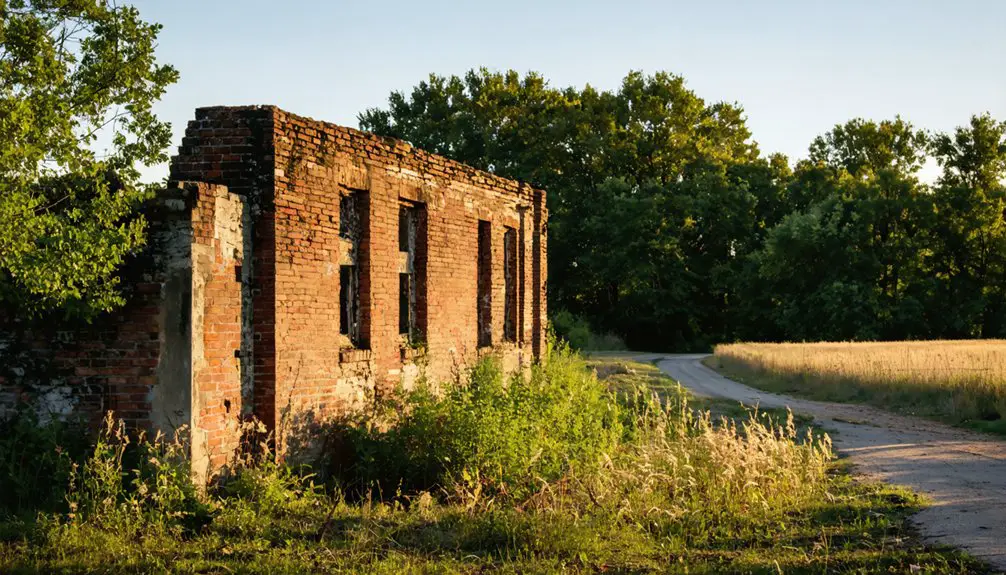You’ll find Essex’s ghost town remnants in Ottawa County, Michigan, where ambitious 1830s developers once planned a metropolis of 142 blocks with pre-built homes and a $40,000 hotel. The Panic of 1837 and Wildcat banking crisis devastated the settlement, causing $350,000 in statewide losses and abandoned dreams. Two brief post office operations (1841-1842 and 1904) mark Essex’s decline from lumber boom to agricultural shift. The town’s preserved structures tell an intriguing tale of Michigan’s speculative frontier.
Key Takeaways
- Essex was established in the 1830s as an ambitious Michigan development project featuring pre-fabricated homes, hotels, and extensive infrastructure.
- The Panic of 1837 and subsequent Wildcat banking crisis caused widespread bankruptcies, turning Essex into a ghost town.
- Two short-lived post offices operated in Essex between 1841-1842 and 1904, reflecting the town’s decline and dwindling population.
- The Port Sheldon Land Company invested $40,000 in a hotel and infrastructure before the economic collapse halted development.
- The abandoned town later transformed into an agricultural area and ghost town tourist destination focusing on historical preservation.
The Rise and Fall of Early Settlement
While many Michigan settlements flourished during the 1830s land boom, Essex emerged as an ambitious development project that would ultimately prove short-lived. The settlement aspirations were grand, with entrepreneurs purchasing extensive tracts to create a modern town complete with pre-fabricated homes, hotels, and public facilities.
You’ll find that urban development moved swiftly at first, as investors poured money into constructing lighthouses, sawmills, piers, and railroad lines. The Port Sheldon Land Company was formed to oversee the ambitious venture. The vision was clear – Essex would become a bustling hub for fishing, shipping, and commerce. The developers acquired 600 acres of land to realize their vision of a thriving new city.
However, the Panic of 1837 devastated the speculative venture, causing widespread bankruptcies among investors and the collapse of local wildcat banks. Within a short time, construction halted, populations dwindled, and Essex’s promising future vanished, leaving behind another Michigan ghost town.
Postal Service History and Community Growth
You’ll find Essex’s postal history mirrors its brief existence as a settlement, with two short-lived post offices operating between 1841-1842 and again in 1904 under Postmaster Arthur B. Meech.
Unlike the uniform delivery costs that were standard across the U.S. Postal Service, Essex’s local rates varied based on distance and terrain.
The post office’s ephemeral nature reflected the area’s declining lumber resources and dwindling population, lasting only about four months in its second iteration.
Mail routes connected Essex to neighboring towns by horseback delivery, though the original post office’s exact location remains unknown to historians.
Before its closure in 1904, Essex had thirty to forty houses scattered throughout the small lumber settlement.
Mail Routes and Population
As settlements like Essex emerged across Michigan’s frontier, mail routes became crucial lifelines that followed the paths of logging roads and rail lines serving sawmill communities.
You’d find postal routes adapting to the ebb and flow of economic activity, connecting workers and families to the outside world through stagecoach and railroad delivery systems.
Community connectivity hinged on these crucial mail services, with Essex’s population growth closely tied to its postal operations.
Like many boom towns, you’d see the population swell when the mills were running strong, drawing immigrant workers from Finland, Sweden, and Norway.
Similar to Aral’s history, which established a post office in 1884, these mail facilities were vital yet often temporary fixtures of lumber towns.
When industries declined, mail service frequency dropped, and populations dwindled, much like Jennings which saw its residents drop to forty by 1930.
The post office’s presence – or absence – became a telling indicator of Essex’s liveliness, directly impacting residents’ decisions to stay or seek opportunities elsewhere.
Postal Operations Timeline
In the late 1800s, Essex’s postal development mirrored the establishment patterns of neighboring Michigan communities like Adrian, Alamo, and Albion, which received their post offices between 1899 and 1903.
While Essex’s exact postal establishment date isn’t recorded, you’ll find its growth aligned with the era’s expansion of Rural Free Delivery service throughout Michigan.
The early British uniform penny postage system introduced in 1840 helped shape postal rate standardization across America, including in small towns like Essex.
You can trace the town’s postal evolution through official site location reports, which documented how Essex’s post office adapted to serve the changing community.
As RFD routes expanded from 1896 onward, they brought increased rural connectivity and economic opportunities to Essex. Under the oversight of U.S. Postmaster General Benjamin Franklin, the foundation for organized postal delivery had been established nearly a century earlier.
However, like many small Michigan towns, Essex eventually faced postal service reductions, marking a turning point in its journey toward becoming a ghost town.
Town Planning and Development Dreams

When Alex Joudon arrived from Pennsylvania in 1835, he brought with him an ambitious vision for a new metropolis in Ottawa County, Michigan.
You’ll find his urban design was remarkably forward-thinking, with plans for 142 blocks containing 24 lots each. The Port Sheldon Land Company purchased 600 acres and began implementing progressive settlement planning that included pre-built homes, churches, schools, and modern amenities. Like the thriving Central Mine post office, the town planners ensured vital community services were part of the development.
You’d have seen an impressive $40,000 Ottawa House hotel, a lighthouse, pier, and even two miles of railroad track laid down.
The development featured innovative pre-fabricated housing solutions and temporary shelters to accommodate early settlers. Similar to many Upper Peninsula settlements, the town eventually became abandoned despite its initial promise. While the town’s founders spared no expense in infrastructure, including a yacht for the harbor, their dreams of creating a thriving urban center ultimately remained unfulfilled.
Economic Hardships and the Wildcat Banking Crisis
You’ll find Essex’s fate was sealed during Michigan’s devastating Wildcat banking crisis of the late 1830s, when fraudulent banking practices and widespread financial collapse left investors and settlers with worthless currency.
The town’s development plans crumbled as bank failures triggered a catastrophic drop in land values, with losses estimated around $350,000 statewide from Wildcat banking schemes alone.
The economic depression that followed turned Essex into one of Michigan’s many ghost towns, as settlers abandoned their dreams amidst the broader banking system’s implosion.
Bank Failures Impact Essex
During the devastating Wildcat Banking Crisis of 1837, Essex’s promising future crumbled as local banks collapsed under the weight of unstable currency and risky loans.
You’d have witnessed widespread banking instability as financial institutions failed, leaving settlers and investors with worthless bank notes and frozen assets.
The Port Sheldon Land Company and other speculators, who’d planned ambitious developments near Essex, couldn’t meet their obligations when their credit lines dried up.
These ghost town dynamics accelerated as construction projects ground to a halt, leaving buildings unfinished and dreams abandoned.
Without access to capital, businesses couldn’t operate, employment opportunities vanished, and residents were forced to leave.
Essex’s decline into a ghost town was sealed, as the economic devastation from these bank failures would take decades to overcome.
Financial Crash Dooms Settlement
The devastating Panic of 1837 delivered a fatal blow to Essex’s ambitious development plans, as the nationwide financial crisis exposed the dangers of wildcat banking practices throughout Michigan’s frontier.
You’ll find that Essex’s settlement strategies, which relied heavily on speculative financing and unreliable paper currency, crumbled when banks began failing across the region.
The town’s economic resilience was tested as credit suddenly dried up, leaving expensive infrastructure projects incomplete and investors unable to secure additional funding.
Without access to capital, Essex’s dreams of becoming a thriving urban center vanished.
Settlers who’d invested their savings in local property and improvements found themselves holding worthless titles, forcing many to abandon their homes and seek opportunities elsewhere.
Investors Face Heavy Losses
Massive financial losses struck Essex’s investors after pouring substantial capital into ambitious development projects across 142 blocks. Your money would’ve vanished as the Wildcat Banking Crisis of 1837 devastated the settlement’s economy, mirroring the collapse of similar ventures like the Port Sheldon Land Company.
The combination of investor speculation and economic mismanagement proved fatal. You’d have seen your investments crumble as unstable wildcat bank notes devalued rapidly, while the $40,000 Ottawa House hotel, churches, schools, and railroad infrastructure stood abandoned.
Well-to-do investors lost nearly everything as credit dried up and settlers fled. The banking crisis’s impact was so severe that Essex remained a ghost town for almost a century, serving as a stark reminder of the risks of unregulated frontier banking.
Daily Life in 19th Century Essex
Life in 19th-century Essex revolved around its bustling economic centers, where wooden homes clustered near sawmills and rail depots served as the backdrop for daily activities.
You’d start your day heading to work at the mill or farm, while your wife might’ve managed the household or run a small store. Daily routines centered around the general store, where you’d trade local goods and catch up on town news.
At the break of dawn, families divided their duties – men to the fields, women to home and shop, everyone gathering at market.
Community gatherings brought everyone together at the one-room schoolhouse and local church, which served as the heart of social life. You’d meet your neighbors at religious services, school functions, and holiday celebrations.
The dirt roads and wooden sidewalks connected you to essential spots like the railroad station, where goods and visitors regularly arrived, keeping Essex connected to the wider world.
Legacy of Abandoned Infrastructure

Walking through Essex today, you’ll find weathered remnants of its once-thriving infrastructure scattered across the landscape. Empty brick schoolhouses and storefronts stand as silent witnesses to the town’s ambitious past, while abandoned buildings that once housed miners and merchants slowly crumble into the earth.
You can trace the town’s industrial legacy through rusted rail lines that once connected Essex to Michigan’s essential transport networks. The industrial remnants tell a stark story of boom-and-bust economics – defunct sawmills and processing facilities that once buzzed with activity now sit dormant.
Pre-fab homes, planned but never completed, hint at development dreams that never materialized. These physical remains serve as powerful reminders of the bold aspirations that drove Essex’s early settlers and investors before economic collapse led to the town’s eventual abandonment.
Agricultural Transformation and Land Use
Despite its initial decline as a ghost town, Essex underwent a remarkable agricultural renaissance that mirrored the success of Port Sheldon’s transformation in the 1930s.
The town’s agricultural resilience became evident as farmers discovered the land’s exceptional suitability for berry cultivation, particularly blueberries, raspberries, and strawberries.
You’ll find that this shift from industrial development to farming wasn’t just a change in land use – it demonstrated thoughtful land stewardship that revitalized the local economy.
The transformation included diversifying into grain production and pickle farming, while establishing essential infrastructure like depots and stores.
The agricultural success attracted new residents and created jobs, turning what was once abandoned territory into thriving farmland.
This agricultural adaptation proved that Essex’s soil could sustain more than just the failed dreams of its industrial past.
Ghost Town Tourism and Historical Preservation
While Essex’s agricultural revival brought economic stability, its historical significance has drawn a different kind of attention.
You’ll find that ghost town preservation efforts have transformed Essex into an educational tourism destination, where guided tours and interpretive programs illuminate life in early Michigan settlements. Local historical societies and volunteer groups work together to protect the remaining structures, implementing specialized conservation techniques that maintain the site’s authenticity.
You can experience Essex’s past through carefully curated exhibits, historical reenactments, and walking tours that showcase the town’s evolution.
Tourism strategies now balance visitor access with site protection, generating revenue through guided experiences and seasonal events while safeguarding fragile historic resources. Community engagement remains essential, as residents share oral histories and participate in preservation initiatives that strengthen their connection to Essex’s heritage.
Lessons From Michigan’s Lost Communities
Through Michigan’s abandoned settlements like Essex, you’ll discover vital lessons about frontier development and economic sustainability.
When communities relied solely on speculative growth or single industries, they couldn’t weather economic storms like the 1837 banking crisis that devastated Port Sheldon’s ambitious $40,000 development.
You’ll find that community resilience depended on building diverse economic foundations beyond just resource extraction or real estate speculation.
Towns that survived learned to adapt – like Port Sheldon’s later revival through berry farming in the 1930s. Economic diversification proved essential for long-term survival.
The ruins of abandoned railroads, hotels, and industrial sites stand as stark reminders that sustainable growth requires more than optimistic investments and grand plans.
Frequently Asked Questions
What Native American Tribes Originally Inhabited the Essex Area Before Settlement?
You’ll find the ancestral lands around Essex were primarily home to the Potawatomi, Ojibwe, and Odawa peoples, while the Wyandot maintained villages nearby and the Fox made occasional incursions through this tribal history.
Are There Any Documented Paranormal Activities or Ghost Stories From Essex?
You won’t find documented ghost sightings or paranormal investigations from Essex. Historical records and research databases don’t show any supernatural accounts from this small ghost town’s relatively uneventful past.
What Happened to the Cemetery and Burial Grounds of Essex?
You’ll find the cemetery still stands, protected by an old wooden fence, with about 90 graves remaining. While there’s been minimal restoration, moss-covered headstones and traditional burial markers continue preserving the site’s history.
Which Prominent Families or Individuals Were the Largest Landowners in Essex?
While early land companies acquired 500-700 acres per venture, you won’t find specific family names recorded as major Essex landowners – records mainly reference unnamed “well-to-do men” and eastern investor syndicates.
Were There Any Notable Crimes or Legal Disputes in Essex’s History?
You won’t find documented crime history or significant legal disputes in the available records. While neighboring towns experienced shootouts and arson, there’s no clear evidence of major conflicts in this settlement.
References
- https://99wfmk.com/one-of-michigans-first-ghost-towns/
- https://witl.com/one-of-michigans-first-ghost-towns/
- https://99wfmk.com/dighton-michigan/
- https://www.onlyinyourstate.com/state-pride/new-york/tahawus-ny
- https://en.wikipedia.org/wiki/List_of_ghost_towns_in_Michigan
- https://gandernewsroom.com/2023/06/28/7-michigan-ghost-towns-you-might-not-find-on-your-map-2/
- https://www.geotab.com/ghost-towns/
- http://www.porterhistory.org/2020/01/a-history-of-porter-county-post-offices.html
- https://www.archives.gov/research/post-offices/locations-1837-1950.html
- https://www.hmdb.org/m.asp?m=234152


